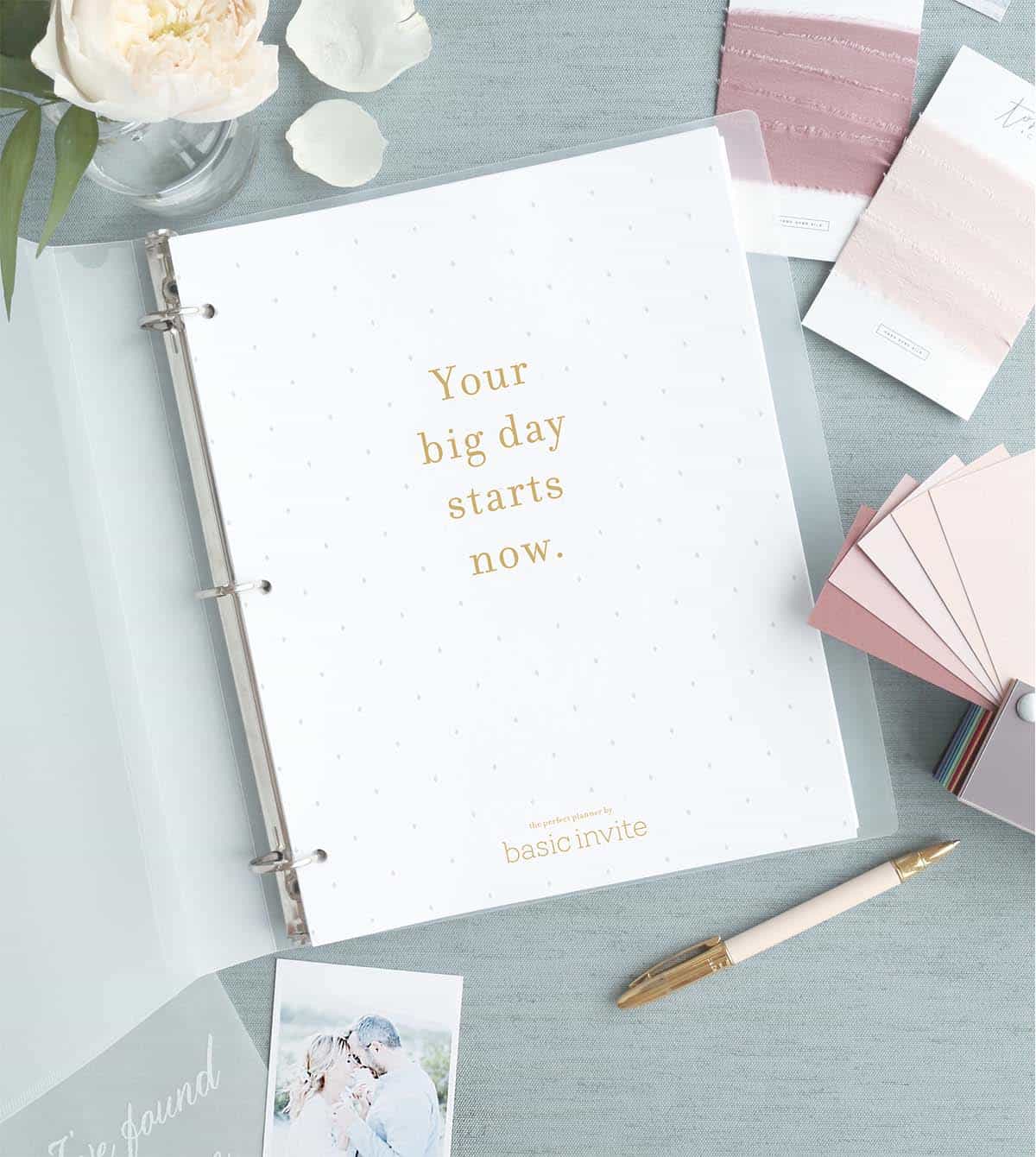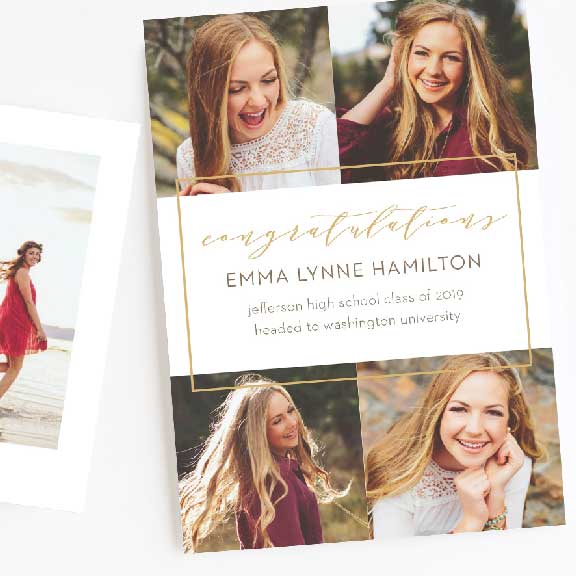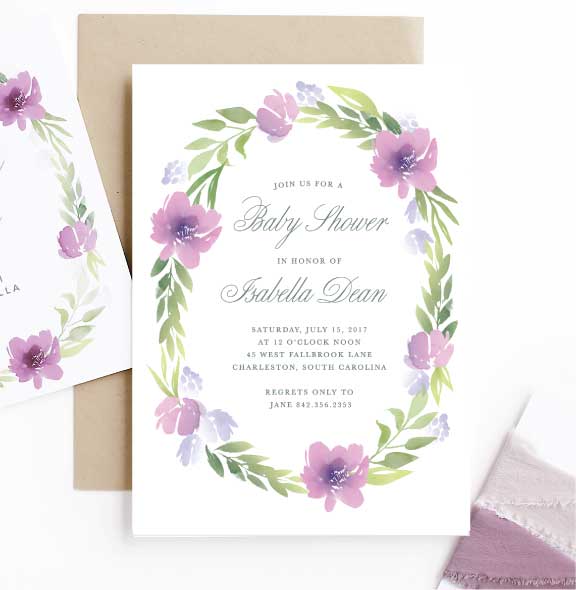Wedding Stationery Wording Tips
Wording your wedding stationery does not have to be burdensome! At Basic Invite we want to get you excited for creating your wedding invitation suite and help you along the way. Follow our Wedding Stationery Wording Tips and guidelines and you will have a fun and easy time with the process of personalizing your wedding stationery. Keep in mind that while there is a proper and formal etiquette for wedding invitations, sometimes it's OK to bend the rules a little, especially with some of our more unique and modern designs. There's also the fact that you can customize basically everything! Read on to find everything you will need to know about wording your wedding stationery. We've broken down each component of the invitation set as well, to guide you to learn what your invitation should consist of.

INVITATION
Your wedding invitation is broken down into 6-7 lines: host line, request line, bride and groom, date and time, location, reception and attire (optional).
HOST LINE
The host line includes the names of those sending out and/or hosting the wedding. Traditionally the bride's parents host the wedding; however, nowadays it's common for the wedding to be hosted by the groom's parents, both sets of parents, or even the bride and groom. When writing this line, be sure to use the hosts' full names.
REQUEST LINE
There are two phrases that are most used: one indicates a religious ceremony and the other does not.
At a place of worship: Request the honor of your presence
Catholic Mass: Request the honor of your presence at the Nuptial Mass uniting
Other Venus: Request the honor of your company
BRIDE AND GROOM LINE
The couple should be the stars of the invitation. Place the names on a separate line, linking them together with to or, and respectively, and using full names: first, middle, and last. The bride's name should precede the groom's name. Traditionally, if the bride's parents are included on the invitations and she shares the same last name then only her first and middle name are used. This same rule follows for the groom.
The Bride's parents are hosting
Mr. and Mrs. John Brown
Request the pleasure of your company at the marriage of their daughter
Emily Mae to Kevin Noah Jones
Visit our Stationery Etiquette page for more examples on wedding invitation wording.
DATE AND TIME LINE
The date should both be written out in full and include the day of the week, date, month and year. When writing the year, this should be placed on a separate line with the option to include the word and (i.e. Two thousand fourteen or Two thousand and fourteen)
Saturday, the second of June
Two thousand fourteen
The time should also be written in full and include "o'clock" after the written time. For a more formal approach use the phrase "in the morning", "in the afternoon", or "in the evening" instead of a.m. or p.m. Any time before 12 p.m. is considered morning, between 12 p.m. and 6 p.m. is afternoon and any time after 6 p.m. is evening. If your wedding begins on the half-hour include a hyphen in the time or for a more formal way use "half past" or "half after" then write the time.
four o'clock in the afternoon
half past four in the afternoon
four-thirty in the afternoon
LOCATION LINE
For the location line include the name of the venue, and address. The address should not use abbreviations, rather it should be written in full. If the address number is smaller than 20, then it should be written out. Also, no punctuation is needed other than a comma between the city and state (which is spelled out). Lastly, zip codes should not be included on any part of the invitation set.
St. (Street) Blvd. (Boulevard) Apt. (Apartment) P.O. Box (Post Office Box)
Central Library
700 Boylston Street
Boston, Massachusetts
RECEPTION LINE
If your wedding ceremony and reception are being held in the same location, include a line at the bottom of your invitation informing your guests. If the reception is going to be at different venue, this should be treated as a separate event with details provided on a reception card. Wording examples of receptions being held in the same venue after the ceremony are:
Reception to follow
Dinner and dancing to follow
Reception immediately following the ceremony
ATTIRE LINE (OPTIONAL)
To advise your guests what should be worn to your ceremony, you can include the optional attire line. This line should be placed at the bottom right hand corner of your invitations. If your wedding is taking place on a lawn or at a beach, it is nice to inform your guests of the elements such as wearing appropriate shoes. Some commonly used phrases are:
Black Tie
Cocktail Attire
Casual Attire
Semi-Formal Attire
PUNCTUATION
Punctuation can be used within the line for dates, time and addresses; However, commas, periods, colons, etc. should not be placed at the end of lines.
ABBREVIATION
Wording such as Names, States and streets should be spelled out in its entirety on invitations, response cards, enclosure cards and envelopes. Exceptions to this rule are:
St. or Sts. = Saint or Saints
Mr., Mrs., Ms., Dr.
Jr., and Sr., separated from the last name by a comma
RESPONSE CARDS
A response card will include the date to RSVP by as well as a line for your guests to write their names, and section to check if they can attend or not. For those hosting dinner, you may also need to place a section for Meal Requests/Dietary restrictions
Happily accepts/ Sadly regrets
Will be there/ Will be there in spirit
Accepts with pleasure/ Declines with regrets
Tip: Be sure to have your response card envelope, pre-addressed and stamped for a quick reply.
ENCLOSURES
Ensure that you match the wording of your enclosure cards, with the wording of you wedding invitations to keep all pieces consistent. Enclosure cards will provide your guest with additional wedding day details, including, transportation, accommodations, directions, reception, other wedding events.
ENVELOPES
When addressing your guests envelopes use titles and full names. It is important to double check your guest list to make sure names are spelled correctly. Common examples of addressing envelopes:
To a Married Couple:
Mr. Patrick and Mrs. Samantha Howard
To an Unmarried Couple Living Together :
Mr. Patrick Howard
Mrs. Samantha Williams
To Those with Other Distinguished Titles:
Judge Howard and Lieutenant Howard, U.S. Navy
Dr. Patrick Howard and Mrs. Samantha Howard
To Children and Families:
Mr. and Mrs. Patrick Howard
Jacob, Brad, Kylie
(Note: If you do not include the child's names you are implying that children are not invited.)
Be sure to stay consistent throughout the invitations set, if dates and times are spelled out on invitations use the same format on your enclosures cards as well. For more examples, for ways to word your wedding stationery, please visit our stationery etiquette page for formal and nontraditional wording. You'll be sure to find something that best fits your style and taste.








